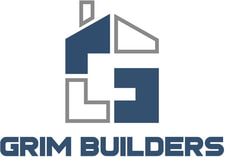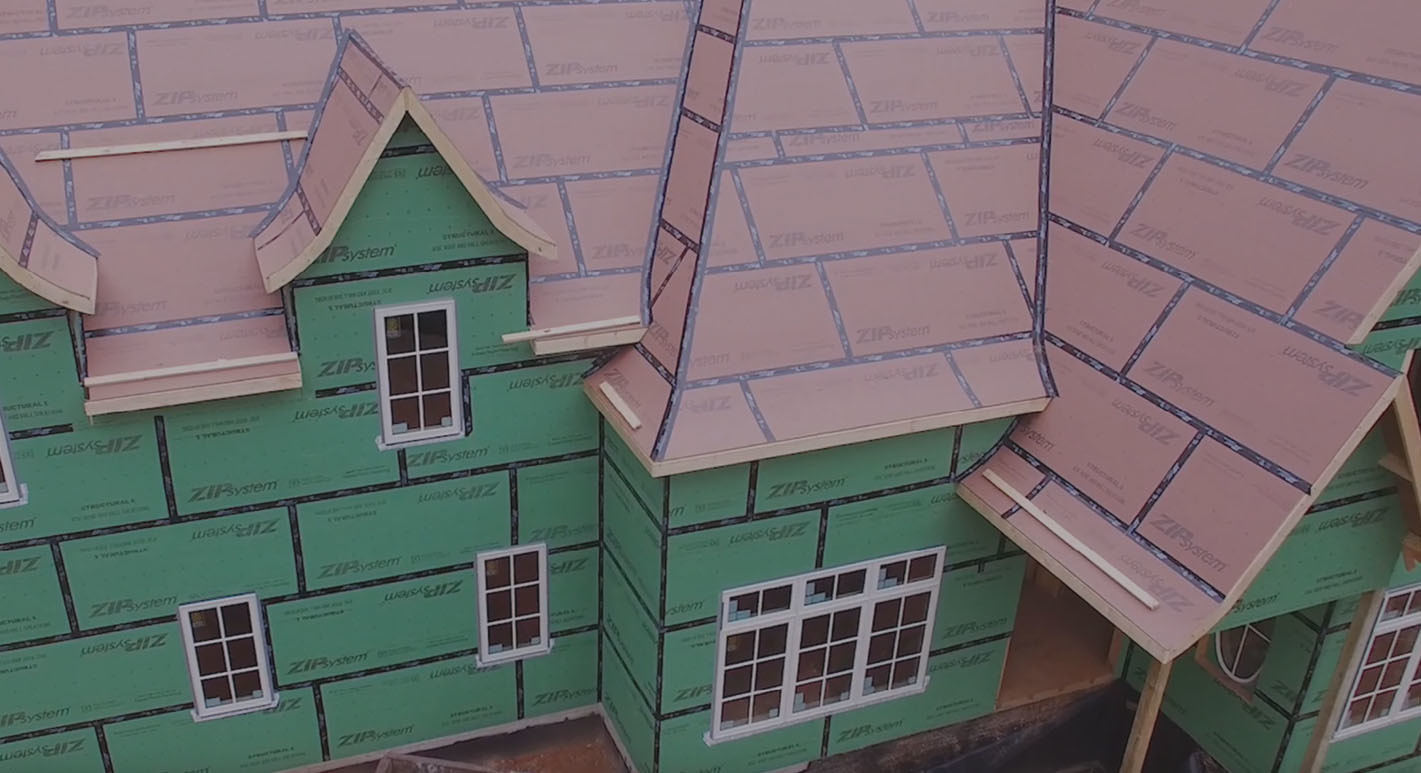|
All homeowners want their homes to be airtight, kept dry, and energy-efficient all year round. Homebuilders in the building process will apply sheathing around the exterior of the house, walls, and the roof. This sheathing keeps moisture, prevents air leakage, and results in a code-compliant home. This process saves homeowners money on energy costs and ensures they live in a comfortable dry environment no matter the temperature outside.
Building homes and sheathing methods have evolved over the years. Many builders have shifted their focus to simplify the process and increase efficiencies in the home building process to be more resilient and resistant to the elements. For years homes have been built using housewrap to protect from water and air; however, that method was less reliable as the housewrap could often tear in the process, reducing the protection of the home and rendering the housewrap unreliable. Builders needed an envelope System they could trust to perform well without sacrificing their bottom. Huber Engineered Woods created the ZIP System as a durable, efficient, reliable solution to antiquated housewrap and wood sheathing. The ZIP System is a Structural 1 engineered wood panel with an integrated water resistance barrier and is completed with an acrylic ZIP System tape at panel seams and flashing details that create an effective water and air barrier. The Benefits of Using ZIP System Sheathing over Housewrap The ZIP System is becoming a top choice for housebuilders everywhere and understandably. Here are the top reasons why the ZIP System is consistently chosen by builders repeatedly. Water-Resistance When it comes to moisture protection, the home's exterior is the first defense, but if that should ever fail, the secondary defense needs to hold strong again invasive water. The ZIP System combines the strength of advanced engineered wood panels with an integrated water-resistive barrier or WRB that is fused into the panel during the manufacturing process. Since the WRB is integrated into the wood panel, there is no risk of tearing. The ZIP System is also designed to allow walls to dry on the outside properly. The integrated ZIP System sheathing panels are engineered with a permeability of 12 to 16 perms, making it higher than the wood panel behind it. The System does not allow moisture to get trapped between the WRB and the panel face. Housewraps, in comparison, are a separate component from the OSB sheathing and are an extra step in the framing process. Because this is a separate component, the housewrap can easily tear due to jobsite conditions, high winds, or storms. If the housewrap is damaged, this can lead to more time needed to complete the build and extra expenses. Additionally, if the housewrap tears, this can expose the wood and framework of the home to the elements and may cause damage. Huber tested the ZIP System Sheathing to the traditional housewrap and found that the ZIP System achieved more than 90% drainage while the housewrap achieved less than 10%. Energy-Efficient Airtight Barrier The ZIP System sheathing and tape provides a technology that creates a continuous barrier created by the taped seams and prevent air from escaping the house. This is a vast improvement considering Air leakage in homes has been the leading cause for up to 25 to 40% of the energy consumed for heating and cooling in a standard residential homes. Rigorous testing and various air pressure levels proved the ZIP System was more efficient at preventing air from leaking than the standard housewrap. The housewrap would easily tear and puncture under the air test pressure and expose the OSB wood panels to the elements. The ZIP System sheathing and tape create a strong air barrier to prevent air infiltration and exfiltration and achieve a tight building envelope. Structural Durability The ZIP System has an integrated structural sheathing System that meets wall bracing requirements and contributes to shear wall assemblies. The engineered wood panel provides a nail-able, easy-to-flash base. Tape Alternative The ZIP System liquid flash is an alternative to the ZIP System Tape for seams and penetrations. The liquid flash helps to reduce the risk of leaks from incorrectly taped joints and penetrations, especially at horizontal joints and simplifies the flashing of irregular-shaped penetrations. The product is easy to use with a simple thickness verification standard. Easy and Quick to Install The ZIP System panels have the WRB layer integrated into the OSB panel. This integrated System can save time installing fully sheathed exterior walls by eliminating the need for sheet-applied WRBs. Additionally, the ZIP System panels are available in longer lengths that allow vertical wall panel installation. Any penetrations are sealed with an effective flashing tape or liquid flash, making the installation process even quicker. Thirty-Year Warranty The ZIP System offers a 30-year warranty, often three times longer than other methods. The warranty does come with contingencies, such as the warranty is only for the original property owner and is not transferable. Frequently Asked Questions Many questions are often asked regarding the ZIP System and the application. Here are some frequent questions regarding the ZIP System process and products to help with a better understanding of why this product is superior. What is the material that ZIP System sheathing panels are made of? The ZIP System wall sheathing is a high-quality, water-resistant OSB (oriented strand board) rated Structural 1 for increased shear capacity. A water-resistant protective barrier is integrated into the panel during the panel manufacturing process. Are ZIP System sheathing panels pressure-treated lumber? The ZIP System sheathing panels do not undergo any chemical or pressure treatment process. Why are there two-color panels in the ZIP System sheathing? There are two colors, brown and green, to identify the System's thickness. The green panels are 7/16" while the brown panels are 1/2" or 5/8" thick. How are the ZIP panels different from the OSB panels? The ZIP System uses a unique blend of hydrophobic resins and waxes. When this blend is mixed with a higher density wood substrate, a panel is created that is more moisture-resistant than a standard OSB. How long can the ZIP System sheathing be exposed to the elements? You need to know how long the building process can expose the ZIP System building enclosure products to the elements during construction. These products have a 180-day Exposure Rating. What is a WRB? WRB stands for the water-resistive barrier. It is the layer of protection from bulk water intrusion in an exterior wall assembly between the structural wall panel and cladding System. The building code requires at least one layer of WRB throughout North America. Does the ZIP System need to be covered with a housewrap? In most scenarios, the ZIP System does not need to be covered with a housewrap. Because the ZIP System panels have the water-resistive barrier built-in, there is not usually a need to add a housewrap to the outside of the structure. The ZIP System is more efficient at keeping water out. Is it possible to install a housewrap over the ZIP System? There are some homes built with exterior claddings (such as stucco) that, because of their material, require additional WRB layers. ZIP System sheathing and tape count as one WRB layer, and builders will need to add either housewrap or another water-resistive barrier. Is ZIP System an air barrier? When combined with a ZIP flashing tape or liquid flash, the ZIP Sheathing System can form a rigid air barrier and can be an effective component of air layer control. Conclusion The ZIP System has a wide variety of products that span from structural panels to sealing solutions designed with the intent to meet code and climate zone regulations. While there is no shortage of product choices, high-quality integrated Systems should be considered to control water intrusion and air leakage and reduce installation steps, which can minimize room for error. The ZIP System is a versatile product that is manufactures in various structural panel and sealing options. It helps build a home that can be put to the test of the elements and time. These panels are designed to meet the residential design and climate zone requirements in multiple regions of the country. The ZIP System is an obvious choice for controlling water intrusion and air leakage that is easy and quick to install. It provides a superior panel combined with solid engineered technology and strength you can rely on. Grim Builders is a full-service construction company in Ledyard, CT. We provide full-service design and remodeling. We can help you take on any project with our skills and tools. Reach out to a building professional at Grim Builders LLC to discuss building options and steps needed to develop your project. Contact us here https://www.grimbuilders.com/contactus.html
0 Comments
Leave a Reply. |
AuthorWrite something about yourself. No need to be fancy, just an overview. ArchivesCategories |
Custom Homes / Additions / Kitchens / Bathrooms / Decking / Basements /Windows & siding / Who We Are / Our Process / Our Work / Contact / Client Info
Grim Builders LLC, 436 Pumpkin Hill Rd, Ledyard, CT, 06339 (860) 271-9794
Copyright © 2019


 RSS Feed
RSS Feed

